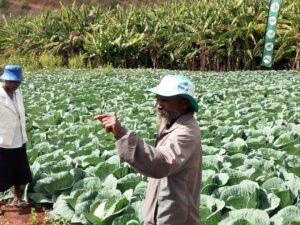Zimbabwe Government in Ambitious 2025 US$1,2 Billion Rural Horticultural Economy
By Delicious Mathuthu
The Zimbabwe Government has announced an ambitious US$1,2 billion rural horticulture economy by end of 2025 to sustain an estimated 1,8 million rural households.
Faced with climate change seen through erratic and extreme weather conditions, the Zimbabwean government is forced to adapt and find new strategies to ensure food and nutritional security in the country.
As the horticulture industry is reportedly on the rebound, Lands, Agriculture, Fisheries, Water and Rural Development Permanent Secretary, Dr John Bhasera, said government is looking to grow the sector up to a US$3,5 billion economy by 2030.
“Priority is achieving beyond food and nutrition security but realising a sustained household income security.
“Scaling up fruit tree production at individual, community, district, province and national levels will enable Zimbabwe more than enough production for her requirements and surplus for exports.
“The overall purpose of the HRGP (Horticulture Recovery and Growth Plan) is to guide and support the revival of the conventional horticulture industry, stimulate a transformative rural horticulture sub-sector under the Presidential Horticulture Scheme covering all 1.8 million rural households.
“The rural horticulture transformation is anchored on the Presidential Horticulture Scheme, which seeks to create and sustain a US$1,217 billion rural horticulture economy by 2025, and up to US$3.5 billion by 2030,” Dr Bhasera said recently during a fruit tree plantation field day at Munjukuya Village, Murehwa in Mashonaland East Province.
Dr Bhasera said the expected household incomes from horticulture production are at US$675 per household each year within the next two years and US$2,000 monthly income per household within the next 7 years.
He said establishing sustainable and effective funding mechanisms and attracting foreign investment to the horticulture sector through improving multi-stakeholder cooperation, coordination and collaboration to strengthen the horticultural value chains are some of the objectives that have been set by government. Reviving horticulture infrastructure and ancillary services which include agro-processing and marketing hubs with associated infrastructure will also be considered.
Smallholder farmers are expected to be the key drivers of the expected turnaround through the Presidential Horticulture Rural Development Scheme.
The scheme’s ultimate goal is to have each household growing 10 fruit trees; each village having a nutrition and income garden and each school in the country having a nutrition and income garden with a fruit tree plantation.
Households will also be encouraged and supported in improved sweet potato varieties cultivation for food and income.
Access produce will be processed for value addition and beneficiation with possible exports.
Promoting indigenous and exotic vegetables and fruit trees improvement and conservation are key interest areas in the scheme.
The Food and Agriculture Organisation (FAO) notes that in Zimbabwe, general challenges facing smallholder farmers (SHF’s) that are hindering growth in the horticulture sector include low and erratic rainfall, low and declining soil fertility, low investment, shortages of farm power, labour and draft animals, poor physical and institutional infrastructure, poverty and recurring food insecurity.
Power is a key driver in agricultural production and the current power crisis in the country will need to be averted first before the target set by government can be achieved.
A study commissioned by the Netherlands Enterprise Agency in 2020 recommended that for a sustainable and high performance horticulture sector in Zimbabwe there is need for specific training support to be developed for improved production of safe and quality fruits and vegetables, as well as for safer marketing practices.
In light of climate change, the study also noted that there is need to overcome the energy hurdles with a bias towards the development of renewable energy
infrastructure like wind, solar, biogas and hydrogen.
Kwedu Classics
Your story our story 


